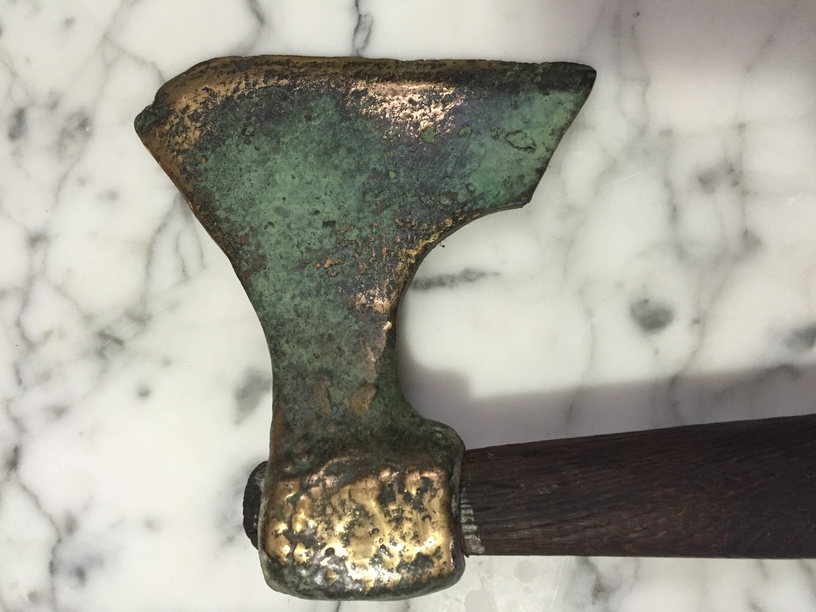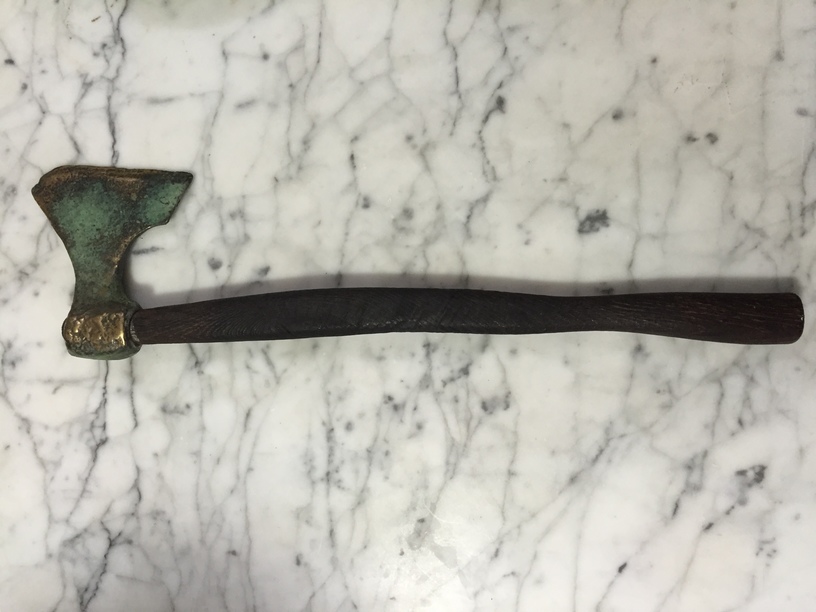| Author |
Message |
|
Joe A
Location: Philadelphia, USA Joined: 17 Oct 2013
Posts: 89
|
 Posted: Mon 21 Mar, 2016 9:29 pm Post subject: Can Anyone Tell Me About This Axe? Posted: Mon 21 Mar, 2016 9:29 pm Post subject: Can Anyone Tell Me About This Axe? |
 |
|
A friend of mine sent me pictures of this axe and asked if I knew what type it was. It seems to have a patina which is unusual for the shape. We don't have any other information except it was found recently in the basement of a house in Philadelphia, PA.
Thanks

 Attachment: 169.18 KB Attachment: 169.18 KB
[ Download ]
 Attachment: 158.99 KB Attachment: 158.99 KB
[ Download ]
 Attachment: 136.11 KB Attachment: 136.11 KB
[ Download ]
|
|
   |
 |
|
Cornelius Engelhardt
|
 Posted: Tue 22 Mar, 2016 12:33 am Post subject: Posted: Tue 22 Mar, 2016 12:33 am Post subject: |
 |
|
Hi!
This isn't an antique. It's a decoration piece.
|
|
  |
 |
|
Håvard Kongsrud
|
 Posted: Tue 22 Mar, 2016 12:46 am Post subject: Posted: Tue 22 Mar, 2016 12:46 am Post subject: |
 |
|
|
Are there any traces of mould lines? What size and weight is it? The blade looks like a distorted version of a Jan Petersen type B, And Aslak Liestøl 1976 type f, but the shape of the eye region points to the medieval or early modern period or later in a nordic context. Could one hazard a guess that it is a copper alloy cast from an original heavily corroded axe, abrased and polished before beeing left in a moist place for too long?
|
|
  |
 |
|
Joe A
Location: Philadelphia, USA Joined: 17 Oct 2013
Posts: 89
|
 Posted: Tue 22 Mar, 2016 6:38 am Post subject: Posted: Tue 22 Mar, 2016 6:38 am Post subject: |
 |
|
| Cornelius Engelhardt wrote: | Hi!
This isn't an antique. It's a decoration piece. |
Do you mean something like a souvenir?
|
|
   |
 |
|
Joe A
Location: Philadelphia, USA Joined: 17 Oct 2013
Posts: 89
|
 Posted: Tue 22 Mar, 2016 6:54 am Post subject: Posted: Tue 22 Mar, 2016 6:54 am Post subject: |
 |
|
| Håvard Kongsrud wrote: | | Are there any traces of mould lines? What size and weight is it? The blade looks like a distorted version of a Jan Petersen type B, And Aslak Liestøl 1976 type f, but the shape of the eye region points to the medieval or early modern period or later in a nordic context. Could one hazard a guess that it is a copper alloy cast from an original heavily corroded axe, abrased and polished before beeing left in a moist place for too long? |
We will check for mould lines.
If the piece is common yellow brass with an artificial patina then it's probably just an artistic reproduction. Why it was made will remain a mystery.
If the metal is historic bronze (copper/tin), the patina real and the wood as old as it appears then it may be an antique.
|
|
   |
 |
James Arlen Gillaspie
Industry Professional

Location: upstate NY Joined: 10 Nov 2005
Posts: 587
|
 Posted: Tue 22 Mar, 2016 9:21 am Post subject: Posted: Tue 22 Mar, 2016 9:21 am Post subject: |
 |
|
It may have also been made for a special purpose, like those tools made of bronze and copper mallets that won't spark when striking in an environment with explosive dust.
jamesarlen.com
|
|
   |
 |
|
Håvard Kongsrud
|
 Posted: Tue 22 Mar, 2016 9:29 am Post subject: Posted: Tue 22 Mar, 2016 9:29 am Post subject: |
 |
|
| Joe A wrote: | | Håvard Kongsrud wrote: | | Are there any traces of mould lines? What size and weight is it? The blade looks like a distorted version of a Jan Petersen type B, And Aslak Liestøl 1976 type f, but the shape of the eye region points to the medieval or early modern period or later in a nordic context. Could one hazard a guess that it is a copper alloy cast from an original heavily corroded axe, abrased and polished before beeing left in a moist place for too long? |
We will check for mould lines.
If the piece is common yellow brass with an artificial patina then it's probably just an artistic reproduction. Why it was made will remain a mystery.
If the metal is historic bronze (copper/tin), the patina real and the wood as old as it appears then it may be an antique. |
I just saw the other images linked to, and I must say the axe head do have som ugly grinding marks where the mould line would have been. I'm with Cornelius on this one.
|
|
  |
 |
Shahril Dzulkifli

|
 Posted: Thu 31 Mar, 2016 5:29 am Post subject: Can Anyone Tell Me About This Axe? Posted: Thu 31 Mar, 2016 5:29 am Post subject: Can Anyone Tell Me About This Axe? |
 |
|
As a decoration piece this axe is not suitable for chopping wood.
I believe its blade can damage easily.

“You have power over your mind - not outside events. Realize this, and you will find strength”
- Marcus Aurelius
|
|
  |
 |
Scott S.

|
 Posted: Thu 31 Mar, 2016 7:06 am Post subject: Posted: Thu 31 Mar, 2016 7:06 am Post subject: |
 |
|
|
In addition to any other observations, I'd venture to say that most hand axes are not usually hafted like that, regardless of pins or wedges being used. As I understand it, when the axe head is mounted, the axe eye is slid up the length of the haft (which widens at the end) in order to work with centrifugal force. I may be entirely wrong, but I'm here to learn.
|
|
  |
 |
|
Gregory J. Liebau
Location: Dinuba, CA Joined: 27 Nov 2004
Posts: 669
|
 Posted: Thu 31 Mar, 2016 7:58 pm Post subject: Posted: Thu 31 Mar, 2016 7:58 pm Post subject: |
 |
|
| Scott S. wrote: | | In addition to any other observations, I'd venture to say that most hand axes are not usually hafted like that, regardless of pins or wedges being used. As I understand it, when the axe head is mounted, the axe eye is slid up the length of the haft (which widens at the end) in order to work with centrifugal force. I may be entirely wrong, but I'm here to learn. |
Yeah, that's pretty much entirely wrong. Most axe heads are placed from the top and have wedges inserted to expand the shaft inside of the socket to secure them. A vast majority of modern tool axes have complex handles similar to the one on this piece - though this is obviously a very crude example.
Do a search on Google Images for "axe shaft wedge" to gain an immediate understanding of the process I'm describing.
-Gregory
|
|
  |
 |
|
|

